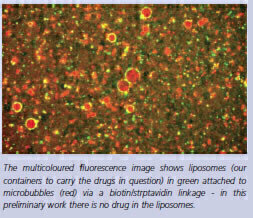News
Bursting Bubbles with Sound Offers New Treatments for Cancer
Oct 27 2010
A new way to deliver cancer drugs using gas bubbles and sound waves is to be developed at the University of Leeds. The project will enable highly toxic drugs to be delivered in small doses directly to tumours, where their toxicity can safely be put to good use. If successful, the technique could easily be adapted for other diseases.The project brings together engineers, physicists, chemists and cancer specialists from across the University to work on the new technique. The research will use existing chemotherapy drugs to gain initial proof of concept before adapting the delivery mechanism for use with novel therapeutics being developed at the University to treat colorectal cancer.
Tiny gas-filled bubbles just a 1000nth of a millimetre across are already used in medicine to provide a clearer image on ultrasound scanners, because, when they are injected into the bloodstream, they reflect a stronger signal than the surrounding tissue. However, certain ultrasound signals will burst the bubbles and it is this phenomenon that the researchers plan to exploit as a clever cancer treatment.The researchers will attach the drug to microbubbles, along with antibodies that are attracted to the tumour to make the bubbles congregate at the tumour site. Ultrasound will then be applied to the site at the correct frequency, and when the bubbles burst a manageable but effective dose of the drug will be released. An added benefit is that ultrasound can also temporarily rupture cell membranes, helping to get the drug into the cells where it can be most effective.
Lead researcher Professor Stephen Evans says: “A number of research teams are looking at possible uses for microbubbles, but with the breadth of expertise available at Leeds we’re in a good position to make a breakthrough. For the technique to be a viable clinical and commercial option, we not only need to find a reliable way to attach the drugs and antibodies, we also need to be able to manufacture the bubbles in sufficient numbers, of the right size and with consistent properties.”
Working on the ultrasound side of the project is Dr Steven Freear from the University’s Faculty of Engineering. He is looking at how specially coded ultrasound waves interact with the microbubbles generated by Professor Evans’ team. The aim is to control the delivery of therapeutic drugs to specific localised sites and encourage their uptake within cells.“The ultrasound wave makes the bubbles resonate, vibrate and finally burst. By changing how we code the electrical excitation signal, we can image and verify how many bubbles are at the site to ensure we administer the right drug dose before we burst them.” explains Dr Freear. “This
means we can use ultrasound, not only to detect and image the microbubbles, but critically to rupture them, delivering the drug payload in a controlled way.”
The bubbles are made from lipids filled with a heavy ‘fluorocarbon’ gas, which has the advantage of not dissolving easily in the bloodstream, thereby ensuring bubbles stay intact until they reach the correct location. One of the aims of the project, funded through the Engineering and Physical Sciences Research Council, is to develop a machine that can manufacture the bubbles at an industrial scale for use in clinical practice.“Current manufacturing methods basically shake up a liquid to create the bubbles but the majority of those aren’t the correct size and so have little therapeutic value,” explains Professor Evans. “This method is fine for bubbles used in imaging where the components are cheap, but once you start using expensive drugs and antibodies, it’s no longer viable. We have some prototype machines we’re working on and hope through the project to bring them closer to commercialisation.”
Researchers from the Leeds Institute of Molecular Medicine with expertise in colorectal cancer will develop and verify the effectiveness of the treatment in cell culture and mouse models. If successful, the team will look for further funding to take the work on towards clinical trials. Professor Evans and Dr Freear will be joined in the research by Dr Neil Thomson from Physics, and Professor Sir Alex Markham, Dr Pam Jones, Dr Louise Coletta, Dr Tony Evans from Medicine and Professor Bushby from Chemistry. The project also involves specialist companies Epigem, Precision Acoustics and Weidlinger Associates and the charity, Leeds and West Riding Medical Research.
Digital Edition
Lab Asia Dec 2025
December 2025
Chromatography Articles- Cutting-edge sample preparation tools help laboratories to stay ahead of the curveMass Spectrometry & Spectroscopy Articles- Unlocking the complexity of metabolomics: Pushi...
View all digital editions
Events
Jan 21 2026 Tokyo, Japan
Jan 28 2026 Tokyo, Japan
Jan 29 2026 New Delhi, India
Feb 07 2026 Boston, MA, USA
Asia Pharma Expo/Asia Lab Expo
Feb 12 2026 Dhaka, Bangladesh



















